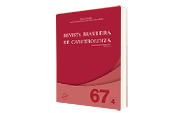Salivary Gland Tumors: a Ten-Year Retrospective Analysis in a Brazilian Teaching Hospital
DOI:
https://doi.org/10.32635/2176-9745.RBC.2021v67n4.1452Keywords:
Salivary Gland Neoplasms, Salivary Glands Minor, Parotid Gland, Adenoma, Pleomorphic, Head and Neck NeoplasmsAbstract
Introduction: The tumors affecting salivary glands have a wide morphological diversity. Objective: This study aimed to examine the prevalence of salivary gland tumors in patients treated at São Lucas Teaching Hospital at the Pontifical Catholic University of Rio Grande do Sul (HSL-PUCRS), in Porto Alegre (RS), Brazil, from 2007 to 2016. Method: A retrospective study analyzing 201 files from the Department of Pathology at the HSL-PUCRS was carried out, by revising the medical records. Results: Seventy-three cases of salivary gland tumors were found, and their electronic and physical medical records were analyzed. Of the 73 cases, 56 (76.7%) were benign tumors and 17 (23.3%) were malignant tumors. The age group with the highest number of cases was between 41 and 60 years of age and the highest prevalence was found in females, with 54.8% of the cases. The parotid gland presented the highest prevalence, accounting for 72.6% of the cases. The predominant neoplasia was the pleomorphic adenoma, accounting for 53.4% of the tumors. The standard of distribution of neoplasms of salivary glands was similar to the encountered in other Brazilian regions. Conclusion: The largest salivary glands were the most affected by neoplastic processes. Pleomorphic adenoma and adenoid cystic carcinoma were the most frequent benign and malignant tumors, respectively, and parotid gland was the most affected site. In the light of previous literature data, the results allow to infer that some demographic characteristics (for example, sex and age) vary among the different geographic regions.
Downloads
Downloads
Published
How to Cite
Issue
Section
License
Os direitos morais e intelectuais dos artigos pertencem aos respectivos autores, que concedem à RBC o direito de publicação.

This work is licensed under a Creative Commons Attribution 4.0 International License.









